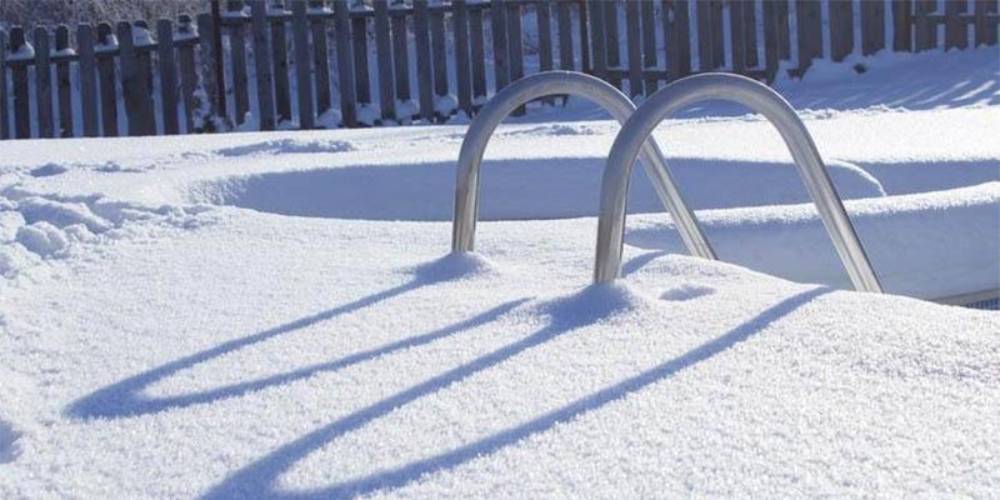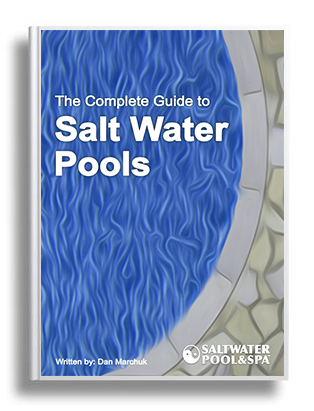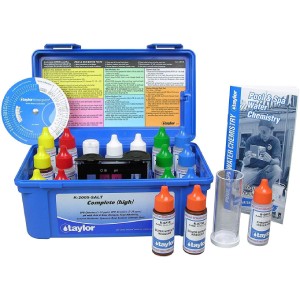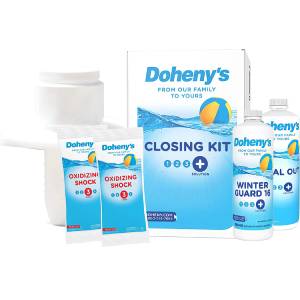- Salt Water Pool and Spa
- Salt Water Pool Maintenance
- Pool Closing
Swimming Pool Closing
Swimming pool closing is something that all pool owners have to do at the end of the season when the weather cools off or you decide to shut the pool down for an extended period of time. A proper winterization routine is essential to keeping your pool healthy while it sits stagnant and your pool system isn't running because this is when it's most susceptible to unhealthy algae growth and potentially expensive damage.

Winterizing is an important step whether you own a salt water pool or a regular chlorine pool and will help make spring start up a whole lot easier as well as reduce the time and chemicals needed to get your pool ready. There is nothing better than removing the cover and finding pool water that looks as good as when you last saw it the previous year. If you have an above ground pool check out our winterizing an above ground pool page with unique steps to ensure you are closing your pool properly.
The Complete Guide to Salt Water Pool MaintenanceEverything you need to know to maintain your salt water pool and keep it running smoothly all season. |
|
Swimming Pool Closing Step by Step
Pool owners that live in the northern United States or Canada that experience freezing temperatures in the winter will have to ensure that all water is removed from the plumbing system to avoid damage to pool hardware. Water that is left to freeze in plumbing will expand and could cause serious damage to expensive parts that will most likely need to be replaced.
If you live in a climate that doesn't experience freezing temperatures in the southern United States or Australia you can get away with not removing water completely from the plumbing but it's still a good idea. Pool owners in this type of climate the goal will be to create a water solution that prevents algae growth and ensures water health without circulation. A properly balanced pool is very important to prevent organisms from flourishing especially with fluctuating temperatures in the offseason.
- Final chemical balancing
- Final cleaning
- Pool closing chemicals
- Lower water level
- Hardware preparation
- Salt water system winter setting (if required)
- Remove accessories
- Place winter cover
1. Final Chemical Balancing
The water chemistry in your pool should be balanced at all times but it's really important that its balanced heading into winterizing. If levels are a bit off you should adjust accordingly to ensure that your closing chemicals work as effectively as possible. For more information on optimal chemistry visit our salt water pool maintenance page that has tips and advice for salt water pool owners.
Taylor Technologies K-2005-Salt Test KitComplete pool water test kit with salinity test. If you click on this link and make a purchase, we may earn a commission. |
|
|
2. Final Cleaning
With the pool water level still full it's a perfect time to give your pool walls and floor a good scrub. We recommend a biodegradable pool cleaner if you find it necessary but good old elbow grease is usually sufficient. Any dirt and residue left to sit over the winter months can end up staining your liner so it's a good idea to get the liner as clean as possible before it's shut down for the winter.
3. Pool Closing Chemicals
A pool closing kit is a convenient way to ensure that you have everything you need to keep your pool healthy during the off season. A good kit will help prevent algae that can sometimes form during fluctuating winter temperatures. It will also prevent cloudy water and if you want to ensure you get your pool water conditioned properly make sure it includes a scale inhibitor, oxidizer and algaecide. Closing kits are designed for use with pool for a certain size or gallonage just ensure that the kit you purchase is rated for the size of your pool.
Scale InhibitorA scale inhibitor will guard against scale, metal staining and the ring that can form along the pool surface liner. A bottle of scale inhibitor is usually enough and should be poured evenly around your pool during application. |
OxidizerA bottle of oxidizer added to the pool water 4-6 hours after the scale inhibitor will dissolve organic matter that your filter doesn't screen out. Available in a chlorine solution or chlorine-free so you can decide which one to use in your pool. |
AlgaecideAn algaecide will prevent your pool from developing algae growth that can form with fluctuating temperatures in the off-season. One bottle is enough mixed in a bucket to dilute and should be poured evenly around the pool. |
Doheny's Pool Winterizing and Closing Chemical KitComplete closing kit with everything you need for the offseason. If you click on this link and make a purchase, we may earn a commission. |
4. Lower Water Level
After you have given your pool liner a good clean it's time to lower the water level. This will ensure that your system does not take any water in and will help reduce staining along the water line. If you are using a mesh cover we recommend lowering the water 12-18 inches and if you are using a floating cover 3-6 inches should be sufficient. If your pool has a drain you can set it to the appropriate setting or you may have to use a water pump or shop vacuum. A gizzmo can be used to plug the intake line in the skimmer for added protection.
5. Hardware Preparation
Electricity should be turned off at the main control panel and plumbing disconnected from the pump, filter, heater, salt system and skimmer. Any water should be drained from adjacent valves and left open to allow for evaporation. If you are using a cartridge filter or D.E. filter the filter cartridges should be cleaned and removed for storage. If you are using a sand pool filter you may have to clean the sand by hand or wait until spring to run a sand filter backwash.
At this point it's important to ensure that all plumbing and equipment are completely free of water and you may want to use a shop vacuum or an industrial blower. Once you are sure that all water is eliminated it's time to refasten plumbing and an expandable rubber plug can be used to plug open airways. If you are unable to remove the water completely you can fill the skimmer with anti-freeze as per manufacturers instructions.
Aquatix Pro 1.5-2.0 Inch Pool Winterizing Expansion PlugRubber expansion plug for winterizing plumbing, skimmers, return and cleaner lines. If you click on this link and make a purchase, we may earn a commission. |
6. Salt Water System Winter Setting
If your salt water system has a winter or neutral setting ensure that it is set properly when you stop using your pool. It's important to remove the cell for the winter especially if you live in a climate with freezing temperatures to avoid damaging the internal components due to water expansion. A good pool cell cleaning with a mild acidic solution is recommended at this time as part of a regular yearly maintenance routine.
7. Remove Pool Accessories
It's time to remove accessories from you pool including anything that isn't water. It's a good idea to give them a good rinse and store them away from the winter elements. Pool accessories include; ladders, diving board, toys, etc. and if you are unable to remove your diving board or slide it's a good idea to cover them with a weather resistant cover to protect it for the winter. If you store them in a pool shed ensure that they are given adequate time to dry before being bundled away and temperatures freeze.
8. Winter Cover
The last step of pool closing is to install an inground pool cover that fits your pool with a little bit of room to spare. The cover will help preserve all the hard work you put into getting your pool ready for winter. A good mesh winter cover that securely fastens to your pool deck is ideal to keep the elements, debris and anything else out of your pool. This step by step guide to pool winterizing will help ensure that your pool remains healthy over the winter months and ready to use in the spring when you open the pool.
Disclaimer
Please use all appropriate and proper safety precautions when attempting projects on this website. All projects are attempted at the reader's own risk.
Salt Water Pool and Spa™ participates in the Amazon Services LLC Associates Program, as an Amazon Associate we may earn a commission from qualifying purchases.



